“Of course, no food economy can or ought to be only local. But the orientation of agriculture to local needs, local possibilities and local limits is simply indispensable to the health of both land and people and undoubtedly to the health of democratic liberties as well”
-Wendell Berry (1998)
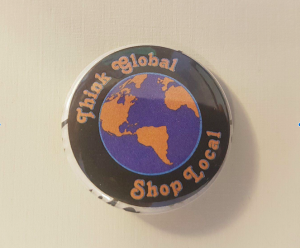
A button made at our booth during the BCAFM Conference!
~~~~~~~~~~~~~~~~~~~~~~~~~~~~~~~~~~~~~~~~~~~~~~~~~~~~~~~~~
We’re over halfway through our project! We want to continue taking you with us on our journey as we reach the home-stretch phase towards project completion.
Weekly Objectives
| Dates | Objectives |
| March 1st : Day Before Conference | Prepare for the BCAFM Conference logistically |
| March 2nd : First Day of BCAFM Conference Weekend
|
Catch the 5pm ferry at Tsawwassen Ferry Terminal
Attend the 7pm BCAFM Welcome Reception at Imagine Studio Café (31 Erie Street)
|
| March 3rd : Second Day of BCAFM Conference Weekend | Interview farmers’ market managers, and also ask for their help to get more vendors to fill our survey
Connect with farmers’ market vendors to fill out our BCAFM vendors’ survey Find out if market managers have archived data of entering and exiting vendors over the past few years and if so, collect their contact information Split up team members to attend as many workshops available as possible Attend Banquet and Farmers’ Market Awards |
| March 4th : Third Day of BCAFM Conference Weekend | Catch 11am ferry back to Vancouver |
Achievements
- Finalized our itinerary for March 2nd- 4th Conference weekend, such as the number of devices and equipment needed, ferry schedule, and confirmed LFS van rental
- Unfortunately, we did not reserve a place for the car for the ferry, and this meant we missed the 5 pm ferry. We ended up checking into Inn at Laurel Point at 9pm
 On our way to the ferry
On our way to the ferry
- Attended six workshops:
- Regional Roundtables — these were meant for a discussion on how farmers’ market can increase regional collaboration. Our group split up to attend the different regions’ conversations. Three of us volunteered as note-takers for the groups, where we wrote down their ideas for collaboration. Dylan especially enjoyed meeting the group from the Okanagan, where his family is from and where he will be working on a farm this summer.
- Traceability: From Farm to Fork — this workshop focused on labelling requirements and restrictions for food sold at farmers’ markets.
- Transparency and Trust — this talk was given by a representative of Washington State’s farmers’ markets. She shared lessons on how to maintain consumer trust by ensuring that vendors are honest about the food they sell.
- Selling your Farm through Social Media — this was a very informative workshop on how to successfully market a farm business through social media, using different platforms such as Facebook, Instagram and Twitter.
- Famers, Markets, and Chefs!– this workshop explored and identified the significant relationships between local farmers, markets and chefs. The speaker also discussed initiatives of the Island Chef Collaborative (ICC) in promoting local and sustainable foods, as well as educating families and community members about healthy eating.
- Received contact information from 15 market manager and obtained qualitative data regarding barriers to entry of new entrant farmers. We accomplished this mostly through interacting with people at our booth
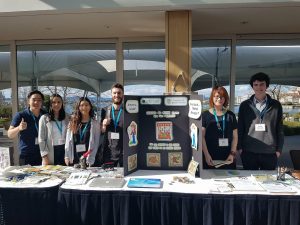 Our booth at the conference
Our booth at the conference
- Checked out of Inn at Laurel Point at 9:30am
Reflections
What
- We were initially surprised that the majority of farmer vendors at the conference had already filled out our survey.
- We were aware that there was not much discussion on farmers’ markets role in contributing to food justice in BC. We also did not hear any discussion around parallel or alternative local food movements. Some of us noticed that when one speaker hailed farmers markets as the “heart and soul of British Columbia’s local food movement”, he failed to acknowledge other local distribution systems.
- We noticed that the vast majority of people attending the conference appeared to be White.
- We were impressed by the friendliness and openness of many of the people in attendance.
So What
- Upon reflection, we realized that it made sense that many of the vendors at the conference had already completed the survey, because those vendors were more likely to be engaged and involved in the BCAFM, and would be quickest to help out by completing the survey.
- We found the lack of acknowledgement of parallel local food movements in BC problematic, because it may contribute to a greater authority of the voices around farmers’ markets compared to other parallel systems in defining what a desirable local food system should look like in BC. Farmers’ markets’ authority in defining the local food system is evidenced in policy documents, that sometimes “treat farmers’ markets as a proxy for the local food system, limiting the conceptualisation of alternative networks to a few privileged spaces” (Gibb and Wittman, 2013, para. 36). This limits respect for and inclusion of diverse ways of knowing in terms of a desirable food system.
- The proportion of people who appeared to be White at the conference reminded us how farmers’ markets may be characterized by Whiteness, which we can define as “bodies with pale skin colour, the changing tendencies of those bodies to do certain things in a particular context and the socio-spatial processes with which those tendencies are linked” (Slocum, 2007, para. 4). We think the Whiteness of farmers’ markets may hinder participation of people from other cultural and ethnic groups, and also ultimately leads to greater authority of White British Columbians in the dialogue around local food.
- We thought it was clear that the people at the conference were passionate about enacting positive change in British Columbia’s food system. Many people seemed to care deeply about environmental sustainability, community inclusion, food sovereignty, and social justice.
Now What
- The fact that many vendors at the conference had already completed the survey made it slightly more difficult for us to collect new data. We had already heard from many of the vendors at the conference, yet still could not access the vendors who were less likely to complete the survey or attend the conference. This helped us realize that BCAFM should begin to request data from market managers on a yearly basis, which would account for the market participants who were less inclined to complete the survey or attend the conference.
- We think the conference could have included more discussion on the limitations of what farmers’ markets can do for food justice. This type of discussion might have been related to issues of access and exclusivity due to price, location, and other reasons. It also could have involved acknowledgement of the diverse ways that local food is flourishing in British Columbia, beyond just the BC farmers’ market channel. The conference might also have acknowledged some of the ways that White privilege is manifested at farmers’ markets, in terms of access, participation, and perceived authority. We understand that it can be difficult to discuss issues of structural privilege and power in the food system, yet we still believe the participants at BC farmers’ markets could aim to be more self-reflexive and engaged with issues of food justice.
- Our observation on the Whiteness of the conference was consistent with what Gibb & Wittman (2013) found in their exploration between efforts of food system localization and racial inequalities, which showed that the local food movement in Metro Vancouver tends not to include Chinese-Canadians in its programmes and policy-making decisions. Moving forward, then, we would like to see government and societal initiatives, programmes, and narratives, doing a better job at including the perspective of parallel local food networks.
- Now that many of the people attending the conference are interested in our findings, we need to properly present our data to BCAFM and, subsequently, communicate our data to some of the conference participants.
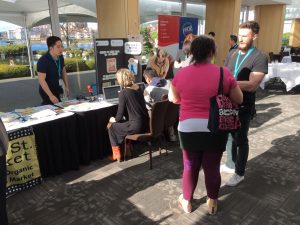
Networking with the conference attendees
After the BCAFM Conference
Upcoming Objectives
| Objectives | Done By |
| Extract data from surveys and analyze results and trends
|
March 12th : Meeting with BCAFM |
| Find data on barriers of entry for farmer vendors in BCAFM
Identify preliminary recommendations for creating a tool to help new farmers enter farmers’ markets |
March 12th : Meeting with BCAFM |
| Create final project presentation and infographic | March 23rd : Infographic due date |
| Continue updating blog with objectives, achievements, and reflections
|
March 30th: Blog 4 due date |
| Write Final Project Report
Provide cleaned dataset that will help BCAFM and future LFS 350 students understand and address the current trends and barriers to entry for farmers into BC Farmers’ Markets
|
April 8th : Final Project Report due date |
Strategies for a Graceful Dismount
- Creating a weekly schedule to keep on top of our work, meeting weekly, maintaining continuous contact with our community partner.
- Using knowledge of statistics to clean and organize our dataset on Excel, which we can give to BCAFM and which can be used in the future by LFS 350 students.
- Using knowledge of statistics as well as data analysis tools in Qualtrics and Excel to analyze our dataset for trends related to barriers to entry.
Moment of Significant Change
What
Our team participated in a “Moment of Significant Change” workshop during our most recent tutorial session. In this workshop, we were asked to illustrate a graph that represents our emotional confidence as well as our knowledge gained throughout the semester (see figures 1 and 2 below). As seen in figure 2, on average, our team members experienced fluctuations of emotions- with high confidence during project phases such as our first team meeting, receiving proposal feedback, and the process of launching our survey, to lower confidence levels experienced during our first meeting with our BCAFM community partners (just due to all the new information and the complexity of the project at hand), and when we received our proposal grade. In figure 3, on average, our team members experienced an increase in knowledge from the beginning of our project (getting assigned to teams) to the period of launching our survey.
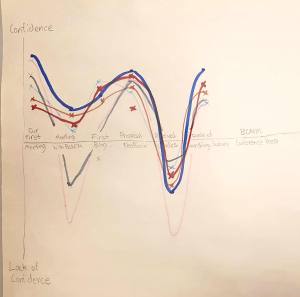
Figure 1: Emotions Graph

Figure 2: Knowledge Graph
Click here for a larger view
So What
Through the Moment of Significant Change workshop, our team was able to reflect on our team dynamics and identify areas that could have been improved. Overall, our team has found that we all work well together. One reason for our great team dynamics may be due to that fact that most of us did not know each other well prior to this project. As Tim Hartford states, being in a team with individuals who you were not friends with before can be more beneficial than being in a group with your friends because working with strangers generally increases creative input and helps you better solve challenging problems (TED, 2015). Additionally, our group members have very diverse backgrounds, and according to Phillips (2014), this can help us during our work because we have to work harder to make sure everyone is on the same page and this often helps generate better ideas. We have really enjoyed getting to know each other and building on each other’s ideas and experiences in our group work. Our trip to Victoria strengthened our team bond and is an experience we will always remember.
Now What
In the next few weeks, we are looking forward to analyzing the survey results and identifying trends in the data. Those who learnt about our project were all supportive and many people look forward to hearing about our findings. We hope our data can provide some practical insights that will help BCAFM improve the flow of new vendors into farmers’ markets. We also hope we can raise awareness around some of farmers’ markets limitations when it comes to contributing to food justice. After completing our Academic Experiential Reviews, we realize that farmers’ markets are in some ways “spaces where a structural inequality across society is realized and enacted” (Hodgins and Fraser, 2018, para. 15). This is due to limited access for some people due to price and convenience, and also due to the greater participation of White British Columbians in farmers’ markets, which subsequently leads to a greater authority for the voices of White British Columbians in defining BC’s local food system. We hope our findings contribute to the viability of BC Farmers’ Markets, and also provide food for thought on how farmers’ markets can do more in contributing to food justice.
Photos From Our Trip

Beautiful Victoria

The view outside of the conference centre
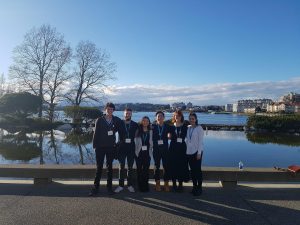
View outside conference centre
References:
Berry, W., 1998: Conserving Communities. In J. Mander, 1998: The Case against the Global Economy, Sierra Club Books, San Francisco, CA, pages 254-263.
Hodgins, K.J., & Fraser, E.D.G. (2018). “We are a business, not a social service agency.” Barriers to widening access for low-income shoppers in alternative food market spaces. Agriculture and Human Values, 35:1, 149-162.
Gibb, N., & Wittman, H. (2013). Parallel alternatives: Chinese-Canadian farmers and the Metro Vancouver local food movement. Local Environment, 18(1), 1 – 19.
Phillips, K. W. (2014). How Diversity Makes Us Smarter. Retrieved March 7, 2018, from http://www.scientificamerican.com/article/how-diversity-makes-us-smarter/
TED. 2015. Tim Hartford: How messy problems can inspire creativity. [Video file]. Retrieved March 8, 2018, from https://www.youtube.com/watch?v=Jd_j_kw_jZQ
Slocum, R. (2007). Whiteness, space, and alternative food practice. Geoforum, 38(3), 520–33.